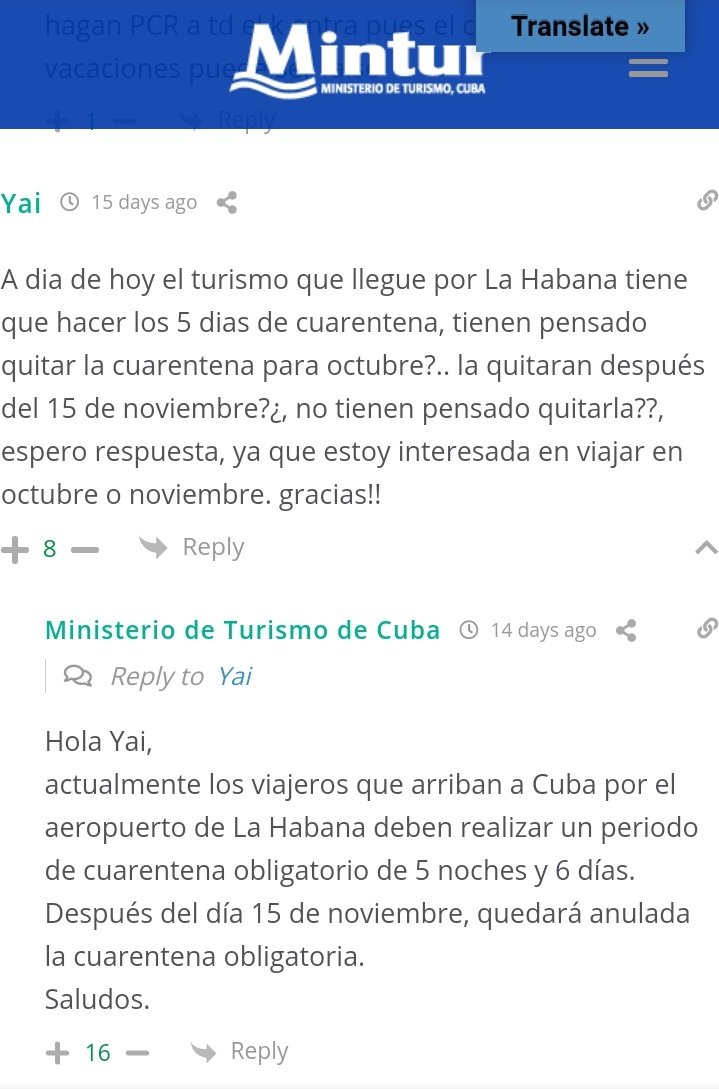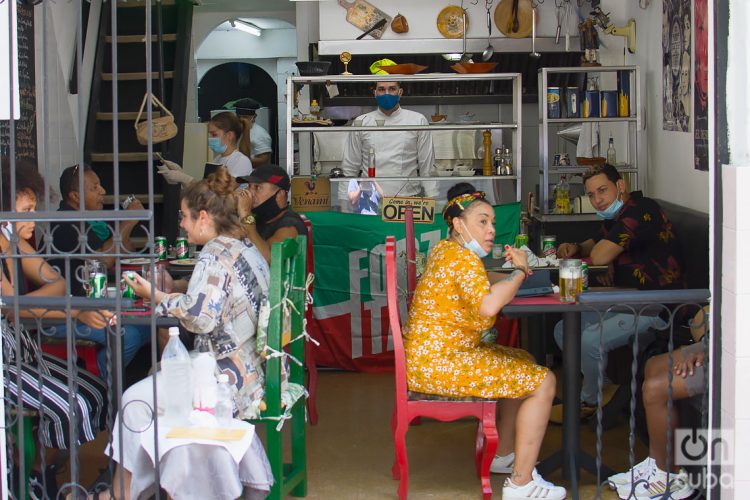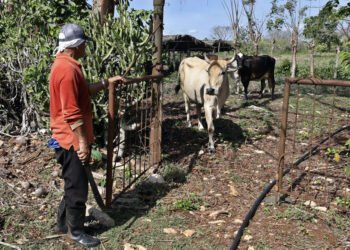When a year ago the Cuban government announced most of the island’s advance to the so-called “new normal,” many people breathed a sigh of relief. Then the light seemed to be seen at the end of the tunnel, after long months of restrictions, human and economic losses, and pandemic exhaustion, and the possibility of a closing of the year with the return of tourism and international flights was assumed as a necessary and encouraging step.
However, there were also those who — logically — preferred not to set bells ringing or celebrate in advance, and even those who put their hands to their heads fearing that the reopening would be hasty and a fatal combination of euphoria, relaxation and indolence would lead to a systematic violation of the health protocols established for the new stage and would open the door to a re-outbreak of COVID-19, as indeed happened.
The “new normal” began on October 12 in most of the Cuban provinces, except in Havana, which entered phase three of the recuperation stage, and Ciego de Ávila and Sancti Spíritus, which, due to a complex epidemiological scenario, remained in limited autochthonous transmission. The reopening of the borders, the restart of foreign tourism — although it had already begun previously in the keys adjacent to the island —, the reestablishment of interprovincial transport and a group of economic activities and services, and the beginning of the new school year In most of the territories, were among the actions implemented, while the authorities appealed to public awareness to stop the spread of the coronavirus and to maintain control of the disease.
However, no matter how much the government defended the validity of the new measures and called for personal and family responsibility to avoid a setback, reality would take a very different course from what was desired and would put the country in an ascending and fatal wave that still resists giving in. If at the end of October 12, Cuba reported 17 cases of COVID-19, already on November 15 when Havana’s José Martí International Airport restarted its regular activities, there were 49 new infections, and in December infections would multiply to the point of exceeding the barrier of 3,000 cases and becoming the month with the most patients detected in the country since the start of the pandemic.
And although these numbers seem insignificant when compared with the most recent official statistics, with days that have exceeded 9,000 infections and months with more than 200,000, along with a sad balance of dozens of deaths per day, the truth is they could be seen as an omen of what was to come. The curve of cases and fatalities would begin a sustained rise, which would force new closures and containment measures, and a reversal of the new government strategy until the “new normal” became just a vague memory.
The arrival in the country of new, more contagious variants of SARS-CoV-2, such as Alpha, Beta, and Delta, and the worsening of the economic crisis and internal shortages due to the accumulated effect of COVID-19 and the impact of the U.S. sanctions, would strain the picture much more. This would cause a pandemic peak in recent months that would exceed the capacities of the country’s health system and exacerbate social unease, which neither the new protocols and restrictions nor the ongoing immunization process, which started at the same time as the Cuban vaccines’ final trials and accelerated after obtaining emergency use permits, have been able to decrease so far.
Cuba: COVID-19 sobrepasa las 7000 muertes, después de los 70 fallecimientos reportados el miércoles
The 2021 remake
Despite the fact that the epidemiological panorama of the island is today light years away from that exhibited in 2020, when the advance to the “new normal” was promoted, and the forecasts do not point to a significant improvement in the short term throughout the country, the government has already announced a remake of what was undertaken 12 months ago. The complex economic situation, catalyzed by the losses and expenses caused by the pandemic ― only in the first semester of this year the State budget had disbursed 5.772 billion pesos for expenses associated with the confrontation with COVID-19 ―, has forced the authorities to take a more pragmatic stance, while betting that the advance of vaccination will gradually reduce the negative statistics.
The immunization process is precisely the main change in the equation if we compare 2021 with the previous period and the greatest hopes are set on it. Until last September 22, more than 19 million doses of the anti-COVID vaccine had already been administered in Cuba, according to the data provided by the Ministry of Public Health (MINSAP). For its part, 77.8% of the Cuban population had already received the first dose of some immunogen, 52.5% had two doses, and 42.7% had completed the three-dose scheme, as part of a program that aims to vaccinate as many people as possible, including children and adolescents, before the end of the current year.
With this perspective, and the commitment to collect income for the diminished state coffers, the government first gave the green light to a greater inflow of tourists and international flights as of mid-November. It is not, as a matter of fact, a reopening of the borders, as the news has focused, since these did not close completely this year, but rather the end of the limitations that existed until now and a necessary boost to a strategic sector of the Cuban economy, hard hit by the pandemic and that until the end of August had received only 163,743 international visitors, 2,960,000 less than in the same period of 2019, and 824,000 less than in the first eight months of 2020.
The reactivation of Cuban tourist destinations and facilities, as well as a greater range of services, including excursions, will be accompanied by more flexible health protocols at the border. This includes the non-requirement of a negative result of a recent PCR test to those who present a COVID-19 vaccination certificate, emphasis on the detection of possible symptoms among travelers, and random diagnostic tests in the air terminals.
In addition, according to the authorities of the sector, the health, distancing and protection measures applied to date in the hotels will be maintained, as well as the presence in these facilities of medical personnel and the existence of premises for the admission and care of detected sick tourists.
Tourists will have to be vaccinated or have a negative PCR upon arrival in Cuba
As for the rest of the travelers, and in particular the Cubans residing or not on the island — whom the government indicated mostly, along with their families, due to the outbreak at the end of 2020 — it seems they will also benefit from the announced flexibility and will no longer have to perform the mandatory quarantine upon arrival in the country, which is currently six or 14 days, depending on the point of entry. Although the official information has not stopped here, the Ministry of Tourism itself, when answering questions and concerns of the population, confirmed that as of November 15 the mandatory isolation will be canceled. This was made known in the comments to the note in which it reported on the upcoming reopening.
If, in fact, in this way, travelers will again have a great weight on their shoulders, because, as it is known, even vaccinated persons can become infected and transmit COVID-19, and could once again be the means for entry into the country of new variants of the virus that affect the epidemiological scenario. For this reason, authorities and specialists once again insist on the importance of care and self-responsibility, not only for those who arrive from abroad and their contacts, but for all Cubans, even when they have already completed the immunization scheme against the infectious disease. And it is that the progressive return to the “new normal” will not be limited only to tourism and flights from abroad and intends to extend to the rest of national life.

A pragmatic and gradual de-escalation
If last year almost the entire island began de-escalation simultaneously ― or, in fact, de-escalations, since there was one in the summer and another, the “new normal,” starting in October —, this time the reopening it will be more differentiated and gradual, as reported by the Cuban authorities, who on this occasion have not made reference to a strategy with pre-established phases, actions and indicators. Now, the process seems to follow more pragmatic paths, based on the health context of each territory, the experience accumulated in more than a year of pandemic and the reality in practice of the previous plans.
Based on this, neither all the localities nor all the services will initiate the de-escalation in parallel, and the government has empowered the local authorities to, based on the analysis of each particular scenario, propose their own reopening plan for when the epidemiological variables allow it.
For now, Havana and Matanzas are already taking the first steps, according to what was said last Thursday on the Mesa Redonda TV program, where the new measures planned for those provinces were announced, which would come into force gradually as of last Friday. In addition, it was announced that six other territories — Cienfuegos, Ciego de Ávila, Santiago de Cuba, Guantánamo, Mayabeque and the Isla de la Juventud — also have the green light to start their de-escalation on presenting a stable situation, even when they have not controlled completely the transmission of the virus. The rest of the country, for now, will have to wait, although it is expected that it can get on the train as vaccination advances and the figures improve.
Empresa de Restaurantes de La Habana prepara reapertura de sus instalaciones
Due to what is already planned, the reopening will begin with the gastronomic services — state and private — in the most advanced provinces, which will be able to have diners at their tables and counters after months of home deliveries and take aways. However, restaurants and cafeterias will have to be certified by the authorities, comply with health and protection measures in customer care and food handling, have natural ventilation, maintain a limited capacity and a distance of about two meters between tables, not offer buffet service and promote reservations by phone or digital means to avoid queues, something that will even apply to the famous Coppelia ice cream parlor in Havana.
The notaries’ offices and civil and property registries will also reopen, through appointments, as well as the workers’ social clubs in the Cuban capital, and the beaches and other public places in Matanzas “as long as citizen discipline prevails and social distancing is not violated.” The hours of these and other services, including shops, legal offices and gastronomy, will be determined by local authorities and may vary from one province to another. Meanwhile, the veto is maintained on bars, discos and nightclubs, as well as parties, dances and other massive celebrations, while no mention has been made of possible attendance at artistic and sporting events ― such as the postponed National Baseball Series —, not even with limited capacity, so, for now, these are also vetoed.
Regarding transportation, urban and inter-municipal — which in the case of the capital is the same and has operated throughout the year with certain restrictions — will again depart for Matanzas as of October and, presumably, for the rest of the provinces authorized to start de-escalation. Interprovincial transportation, meanwhile, has not yet been authorized, not even between the territories with a more favorable situation, and it continues to be restricted to specific situations and with the permission of the authorities. And the classes, which have already started through television and distance learning, must be resumed in person in accordance with the epidemiological panorama and the conclusion of the vaccination of children and adolescents.
With these steps, Cuba seeks to move towards the “new normal” and progressively overcome the impact of a pandemic that has made a dent in the economy and people and that, even today, continues to wreak havoc on the island. “The goal is to share as a family and that, acting responsibly, we can, in the shortest possible time, combat the pandemic and revive the Cuban economy, with all the measures that the government has adopted in recent months,” Minister of Domestic Trade Betsy Díaz Velázquez commented on the Mesa Redonda TV program.
That is the authorities’ aim, in tune with the desire of the Cuban population to leave behind once and for all the nightmare of COVID-19, even when life does not return to be exactly as before and precautions and measures must be maintained. necessary in the “new normal.” However, there are not a few who again wonder if the reopening is not hasty and are suspicious and worried about the possibility that what happened the previous year could be repeated. Already other countries, even with advanced vaccination coverage, according to the critics, have experienced outbreaks after the start of the de-escalation. And although we hope that it does not happen, time, in any case, will again have the last word.











good info